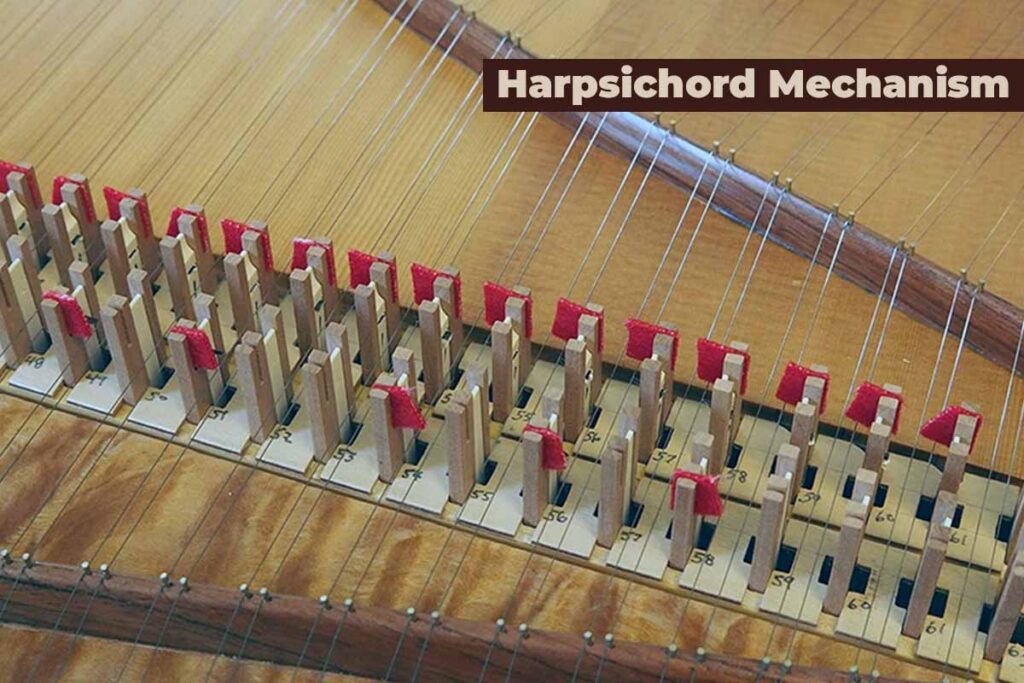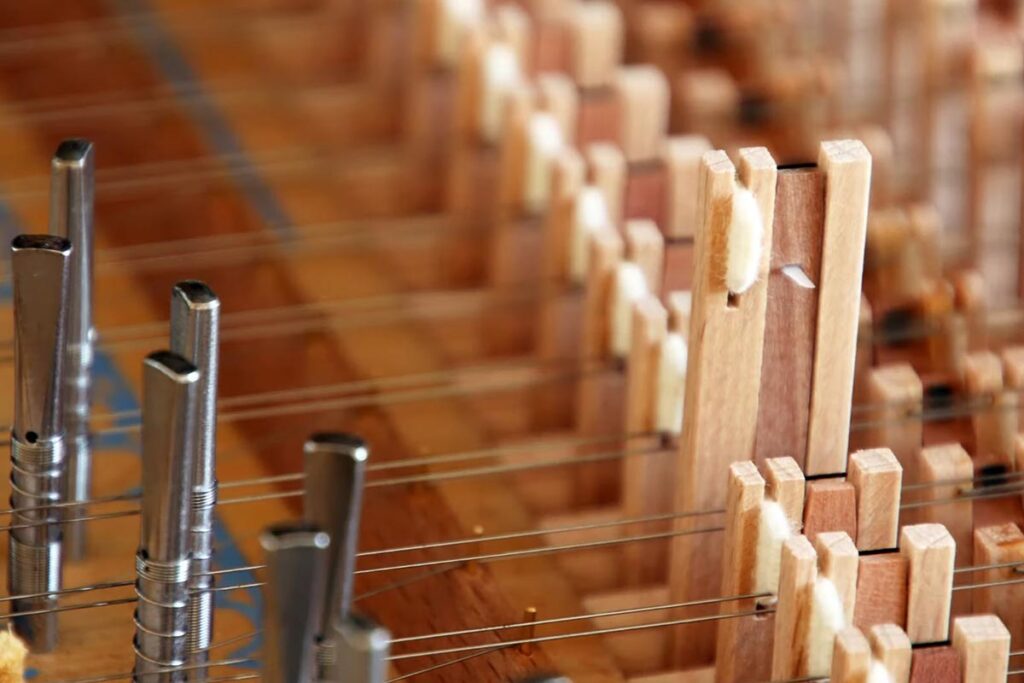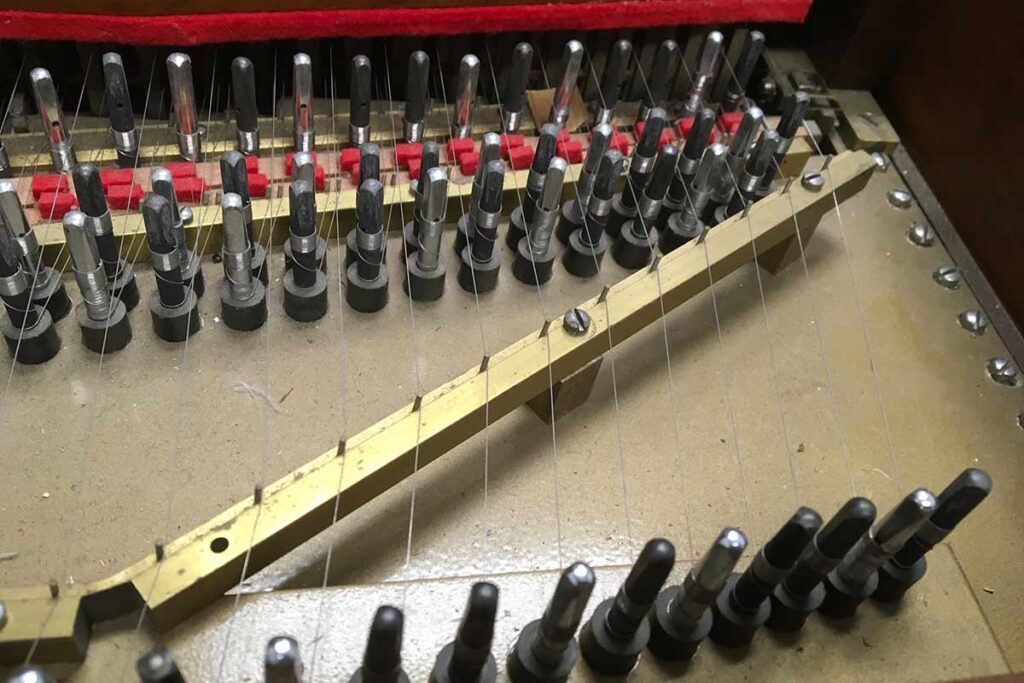What You Need To Know About Harpsichord Mechanism

Harpsichord Mechanism
The harpsichord mechanism refers to the intricate system of components and mechanisms that enable the operation of a harpsichord, a keyboard instrument from the Baroque era.
This mechanism includes various parts such as keys, jacks, plectra, strings, tuning pins, hitch pins, and other internal components.
When a key is pressed on the harpsichord, it activates a series of actions within the mechanism, causing a plectrum to pluck the corresponding string, producing sound.
Understanding the harpsichord mechanism is essential for appreciating the instrument’s unique sound and historical significance.
In this blog post, we talk about intricate harpsichord mechanisms, exploring the fascinating workings behind this timeless instrument.
Join us as we unravel the secrets of the harpsichord, from its elegant keys to the exquisite plucking of strings, and discover the magic that brings music to life.
Harpsichord Mechanism: Jacks

Inside a harpsichord are what are called jacks, which can be made of either plastic or wood—originally, they were made of wood, of course, historically.
Each key on a harpsichord is really just a long lever, so when you depress a key, the other end of the lever pushes up the jack, and it plucks the string.
Part of Harpsichord Jack

The thing that actually plucks the string is called a plectrum. The diagram above shows the jack of the harpsichord.
So, there’s the body of the jack and then the part called the plectrum, and that is what plucks the string.
Plectrum
If you look very closely at the plectrum, you can see that it’s not an even thickness throughout.
This is so that it slips smoothly over the string. And you create this sort of uneven thickness using an exacto knife or a scalpel in a process called voicing, which you will see on every plectrum in the instrument.
Plectra were originally made of bird quill. Today, they are sometimes still made of bird quill, but they can also be made of a plastic called delrin.
Delrin comes in both black and white varieties and has a slightly different feel inside the instrument.
Tongue and Spring
The jack also contains what’s called a tongue, which is the part that the plectrum sits in. And then there’s what’s called a spring. It’s not an actual spring on plastic jacks, although it can be on
wooden jacks.
On wooden jacks, the spring is usually made of a bore bristle or a piece of wire, but here it’s plastic. What the tongue and the spring allow for is for the string on the harpsichord to only be plucked on the way up and not also on the way back down.
They do this by moving out of the way and slipping past the string when the plectrum touches the string on the way back down.
If you look inside the harpsichord while stiking the key, you can see what the jack looks like from the back when it’s plucking the string.
You will also see the motion of the tongue and the spring and how they move the plectrum out of the way so it doesn’t strike the string on the way back down.
There’s also a small noise as the plectrum slips past the string, which is audible when playing the harpsichord.
Jack Rail
Now the jacks aren’t visible when the instrument is played.
There’s actually a piece of wood, called a jack rail, with felt that goes over the jacks that keeps the jacks from popping out of the instrument when it’s being played.
The jack rail goes on top of the instrument’s jacks diagonally and holds the jumping jack in place.
Harpsichord Mechanism: Strings
There are harpsichords with one set of strings, but harpsichords often have two keyboards and two or more sets of strings.
On a normally-shaped harpsichord with one keyboard, it is possible to have two sets of strings instead of just one.
Both sets will be tuned to the same pitches but sound slightly different, with one of the registers usually having a more nasal sound because it’s plucked closer to the bridge of the instrument.
Which set of strings is playing is controlled by levers that can be moved back and forth. These levers can be on the inside of the case, on the outside above the keys, or even sticking out of the side of the instrument.
On the single manual instruments, each set of strings can be played alone or they can be played together, which is called coupling the strings, which creates a louder and fuller sound.
Two keyboards with Harpsichord Strings
Harpsichords with two keyboards also have two sets of strings, one for each keyboard, but they also often additionally have a third set of strings, which is pitched one octave higher.
The normally pitched strings are called eight-foot strings, which is terminology borrowed from pipe organs and doesn’t actually mean that
The strings are eight feet long. The strings pitched one octave higher are called four-foot strings, after the same organ terminology.
To couple the sets of strings or play them together on a double-manual harpsichord, you generally push the upper hand in towards the body of the instrument.
Then the two keyboards play together if you play on the lower manual, and you can see both the keys move together at the same time.
The two eight-foot sets of strings and the four-foot set of strings can all be played together on a double manual harpsichord, which creates the loudest sound, or you could combine just the two eight-foots or one eight-foot and the four.
When two or more sets of strings are coupled together, harpsichords that are well maintained will have a small stagger between when each set of strings gets plucked.
Harpsichords also sometimes have what’s called a buff stop, often called a lute stop as well, where small pieces of leather can be moved to touch the strings, muting the sound and making the harpsichord sound more like a lute.
Harpsichord Mechanism: Tuning Pins and Hitch Pins

The strings in a harpsichord are attached to tuning pins at one end and hitch pins—also called end pins—at the other.
Tuning pins can be either zither-style, also called new style, which was used on many 20th-century harpsichords, or historical-style, also called old style, which was used on the original harpsichords and is used again now by most harpsichord builders.
The strings can be made of yellow brass, red brass, iron, or steel. Each material produces a different timbre when the string is plucked.
They are strung over the soundboard, which can be highly decorated.
The soundboard usually contains what’s called a “rose,” which, like the f-holes on a violin, serves both an acoustic and an aesthetic purpose.
The strings are also run over a bridge and a nut. A harpsichord’s case is often highly decorated, with the inside of the lid being a prime location for paintings.
While every harpsichord contains all these elements, harpsichords are also not at all standardized, and each one is somewhat different from the next.
Final Note
Exploring the inner workings of the harpsichord reveals its true brilliance.
Despite its simple appearance, this instrument hides a complex dance of mechanics, with each part playing a vital role in creating its unique sound.
The harpsichord mechanism isn’t just a feat of engineering; it’s like an artist’s paintbrush, allowing composers to create colorful musical masterpieces.
From the graceful keys to the careful plucking of the strings, every aspect of the harpsichord mechanism showcases human creativity at its best.
Understanding how it works adds a new level of wonder to the music it makes, letting us appreciate the magic behind this timeless instrument.
So, the next time you hear the harpsichord’s enchanting melody, think about the fascinating mechanics that make it possible, weaving stories of innovation and musical delight.
At Phamox Music, we go all out for exactness and honesty. For this purpose, if by any means you found any possible glitch, be it factual, editorial, or something that we need to update, kindly contact us.
If you find the information provided in this post about “Harpsichord Mechanism” interesting and helpful, kindly share it with someone you know that might need it.







